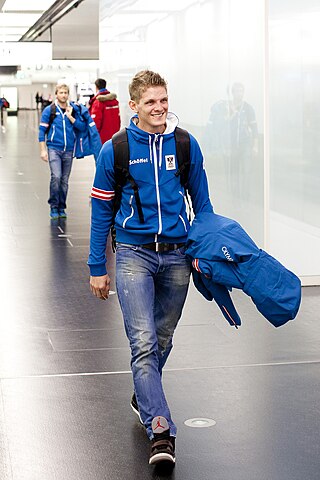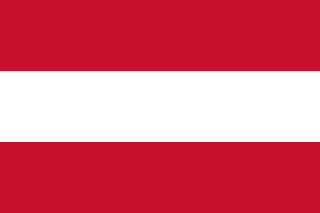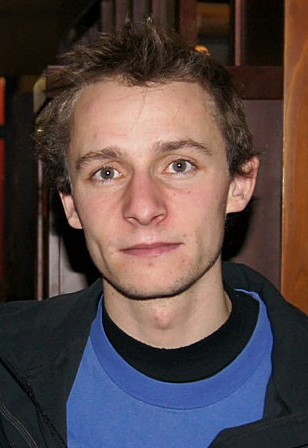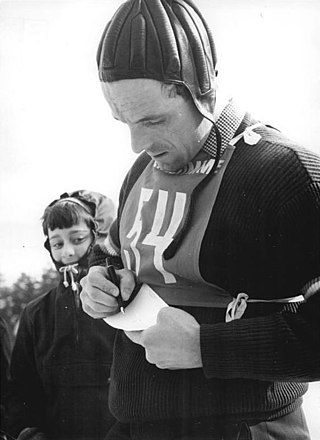
The 1964 Winter Olympics, officially known as the IX Olympic Winter Games and commonly known as Innsbruck 1964, were a winter multi-sport event which was celebrated in Innsbruck, Austria, from January 29 to February 9, 1964. The city was already an Olympic candidate, unsuccessfully bidding to host the 1960 Games. Innsbruck won the 1964 Games bid, defeating the cities of Calgary in Canada and Lahti in Finland. The sports venues, many of which were built for the Games, were located within a radius of 20 km (12 mi) around Innsbruck. The Games included 1,091 athletes from 36 nations, which was a record for the Winter Games at the time. Athletes participated in six sports and ten disciplines which bring together a total of thirty-four official events, seven more than the 1960 Winter Olympic Games. The luge made its debut on the Olympic program. Three Asian nations made their Winter Games debut: North Korea, India and Mongolia.

The 1976 Winter Olympics, officially known as the XII Olympic Winter Games and commonly known as Innsbruck 1976, were a winter multi-sport event celebrated in Innsbruck, Austria, from February 4 to 15, 1976. The games were awarded to Innsbruck after Denver, the original host city, withdrew in 1972. This was the second time the Tyrolean capital had hosted the Winter Olympics, having first done so in 1964.

Thomas Morgenstern is an Austrian former ski jumper who competed from 2002 to 2014. He is one of the most successful ski jumpers of all time, having won the World Cup overall title twice with 23 individual wins, the Four Hills Tournament and the Nordic Tournament once each, eight World Championship gold medals, and three Winter Olympic gold medals.
Jari Markus Puikkonen is a Finnish former ski jumper.
Ski jumping at the 1964 Winter Olympics consisted of two events held from 31 January to 9 February, with the large hill event taking place at Bergiselschanze, and the normal hill event at Seefeld. For the first time at the olympics, more than one ski jumping event was contested, with the addition of a normal hill competition.

Ski jumping has been included in the program of every Winter Olympic Games. From 1924 through to 1956, the competition involved jumping from one hill whose length varied from each edition of the games to the next.

Austria was the host nation for the 1976 Winter Olympics in Innsbruck. It was the second time that Austria had hosted the Winter Games, after the 1964 Winter Olympics, also in Innsbruck.

Gregor Schlierenzauer is an Austrian former ski jumper who competed from 2006 to 2021. He is one of the most successful ski jumpers of all time, having won the Ski Jumping World Cup overall title, the Four Hills Tournament, and Nordic Tournament twice each; the Ski Flying World Cup overall title three times; as well as four medals at the Winter Olympics, twelve at the Ski Jumping World Championships, and five at the Ski Flying World Championships.

Sebastian Colloredoa.k.a. "Sebo" or "Collo", is an Italian ski jumper who has competed since 2002. Competing in two Winter Olympics, he earned his best finish of 11th in the team large hill event at Turin in 2006 while his best individual finish was 27th twice.

The Bergisel Ski Jump, whose stadium has a capacity of 26,000, is a ski jumping hill located in Bergisel in Innsbruck, Austria. It is one of the more important venues in the FIS Ski Jumping World Cup, annually hosting the third competition of the prestigious Four Hills Tournament.
The men's individual normal hill/10 km Nordic combined competition for the 2010 Winter Olympics in Vancouver, Canada, was held at Whistler Olympic Park in Whistler, British Columbia, on 14 February.

Wilhelm "Willi" Egger was an Austrian Nordic combined skier and ski jumper who competed from the late 1950s to the mid-1960s.
For the 1964 Winter Olympics in Innsbruck, Austria, a total of eight sports venues were used. Luge made its debut at these games, but were marred by the death of a British slider two weeks prior to the Games. A second ski jumping event debuted and the best two out of three jumps were used in both events for the only time in the history of the Winter Olympics. All eight venues would be used again when the Winter Games returned to Innsbruck twelve years later though the venues would undergo renovations in time for the 1976 Games.
For the 1972 Winter Olympics in Sapporo, Japan, a total of twelve sports venues were used. A thirteenth venue which was a reserved luge course was constructed, but never used in actual competition. Construction on all of the venues used took place between 1968 and early 1971 in time for the test events. The Tsuskisamu Indoor Skating Rink was not completed until late 1971 or early 1972 because the number of teams scheduled to compete at the 1972 Games was not known. At the actual luge venue used, a malfunctioning starting gate during the first run led to the results being cancelled and rerun being ordered. The results of this event led to the only tie in Olympic luge history. The ski jumps at Miyanomori and Okurayama served as host venues for the FIS Nordic World Ski Championships thirty-five years later.

Thomas Diethart is an Austrian former ski jumper who won the 2014 Four Hills Tournament.

The 41st FIS Nordic World Ski Championships were held from 20 February to 3 March 2019 in Seefeld in Tirol, Tyrol, Austria. It was the second time Seefeld in Tirol hosted the world championships, the event having been hosted there previously in 1985.
The men's large hill individual ski jumping competition for the 1976 Winter Olympics was held in Bergiselschanze. It occurred on 15 February.
The men's normal hill individual ski jumping competition for the 1976 Winter Olympics was held at Seefeld. It took place on 15 February.

The men's normal hill individual ski jumping competition for the 1964 Winter Olympics was held at Seefeld. It occurred on 31 January.













